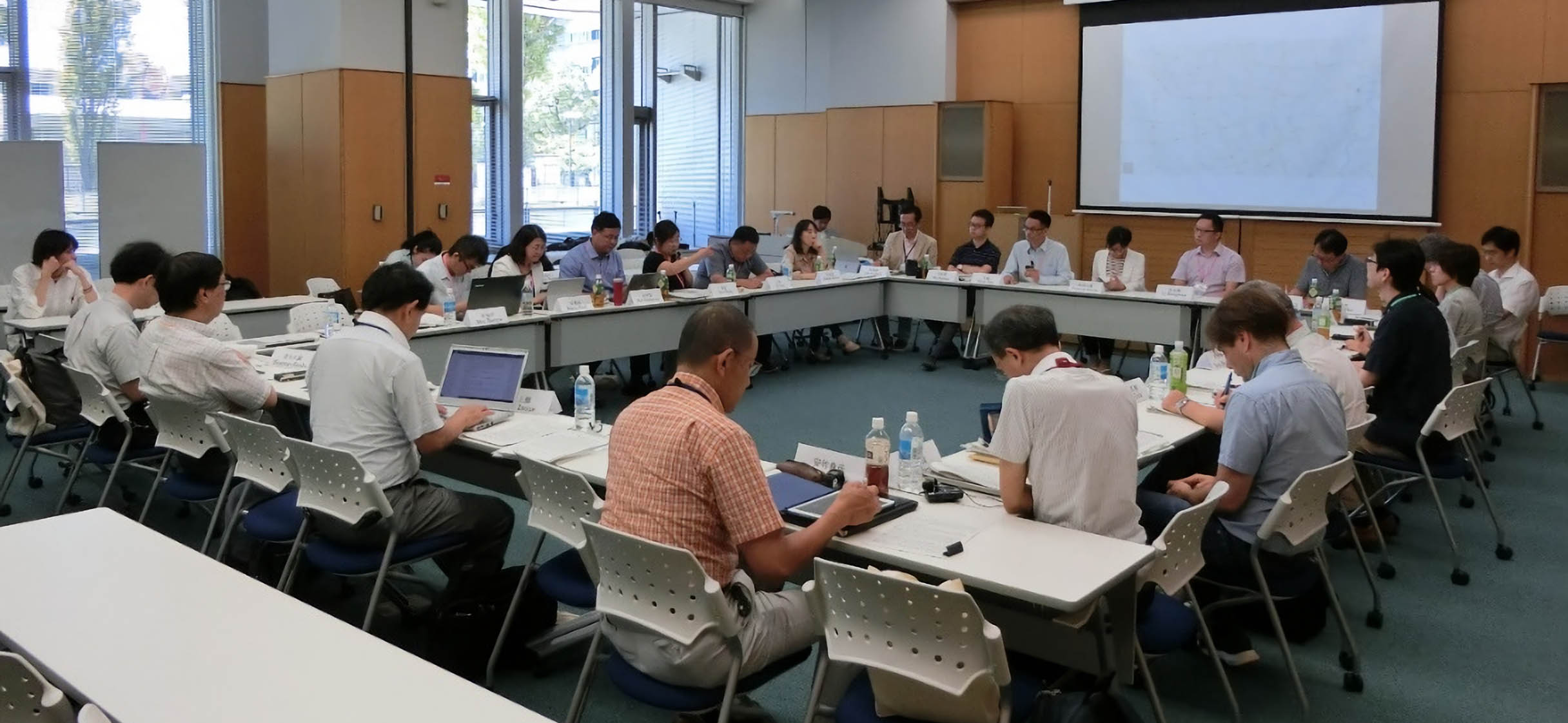This event was the second part of the General Symposium for the Marginal Social Groups’ Experiences of Modernity Project, an international collaborative research program involving Osaka City University (OCU), Yale University, the National University of Singapore (NUS), and Shanghai University. Following on the symposium held in September 2019 with scholars from the United States and Singapore, this second session hosted scholars from Shanghai under two organizing themes: first, examination of social groups and social structure in Osaka and Shanghai from the perspectives of socio-space, culture, and daily life, and, second, the characteristics of the historical documents through which we approach these phenomena. The aim was to create a shared space of possibility for comparative history and collaborative research by bringing Japanese and Chinese sources into conversation. The symposium, with presentations and discussion held in both Chinese and Japanese, took place over the weekend of 7-8 September 2019 in the Cultural Exchange Room on the first floor of the Osaka City University Media Center.
Day 1: 7 September (Sat) 10:00am-5:00pm
Welcome Session
The symposium began with welcome addresses by Sakuragi Hiroyuki, Vice President of Osaka City University; Kobayashi Naoyuki, Dean of the Graduate School of Literature and Human Sciences; and Tsukada Takashi, Professor in the Graduate School; Prof. Ma Xueqiang of the Institute of History at the Shanghai Academy of Social Sciences;, and Prof. Zhang Zhihui of Shanghai University. Excerpts from their remarks are presented below.
Sakuragi Hiroyuki
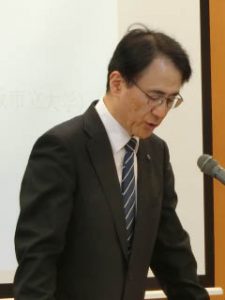 “At Osaka City University, we have, especially of late, been working towards the internationalization of education and research. To achieve that goal, I believe it is vital for researchers and students from around the world to build up, slowly and steadily, spaces and opportunities for real-world communication such as this symposium provides, conversing face-to-face about common themes, deepening understanding, and thereby giving birth to new knowledge. I thank Professors Ma Xueqiang, Zhang Zhihui, Tsukada Takashi, and the many others involved for their hard work in organizing this symposium.”
“At Osaka City University, we have, especially of late, been working towards the internationalization of education and research. To achieve that goal, I believe it is vital for researchers and students from around the world to build up, slowly and steadily, spaces and opportunities for real-world communication such as this symposium provides, conversing face-to-face about common themes, deepening understanding, and thereby giving birth to new knowledge. I thank Professors Ma Xueqiang, Zhang Zhihui, Tsukada Takashi, and the many others involved for their hard work in organizing this symposium.”
Kobayashi Naoki (read by Saga Ashita)
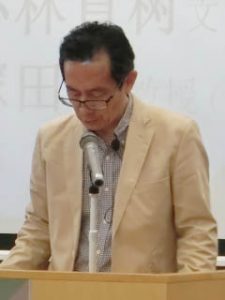 “The Marginal Social Groups’ Experiences of Modernity Project, begun in 2017, is now in its final year, but it will provide the nucleus for an international scholarly symposium to be hosted next year and, what is more, we are working on plans to continue, on a permanent basis, international research collaboration and exchange of junior scholars. I believe that this symposium— conceived with the intention of bringing historical research methodologies in China and Japan into conversation so that each may examine the other and absorb its strengths—is an extraordinarily promising endeavor. I hope fervently for its success.”
“The Marginal Social Groups’ Experiences of Modernity Project, begun in 2017, is now in its final year, but it will provide the nucleus for an international scholarly symposium to be hosted next year and, what is more, we are working on plans to continue, on a permanent basis, international research collaboration and exchange of junior scholars. I believe that this symposium— conceived with the intention of bringing historical research methodologies in China and Japan into conversation so that each may examine the other and absorb its strengths—is an extraordinarily promising endeavor. I hope fervently for its success.”
Tsukada Takashi
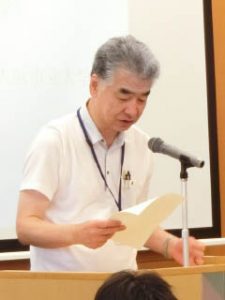 “Together with our colleagues from Shanghai, we have built a deep collaborative relationship. So far, among other efforts, we have convened international symposiums at Shanghai University three times and once at the Shanghai Academy of Social Sciences. And today we welcome nine colleagues from Shanghai to Japan. At this symposium we will discuss Shanghai and Osaka from a diversity of perspectives, and by beginning our thinking about these societies from the nature of their respective archives—what, how, and why sources have come down to us—we hope to create bridges between them through comparative historical research. I look forward to working together with you all to make this symposium another fruitful meeting of minds.”
“Together with our colleagues from Shanghai, we have built a deep collaborative relationship. So far, among other efforts, we have convened international symposiums at Shanghai University three times and once at the Shanghai Academy of Social Sciences. And today we welcome nine colleagues from Shanghai to Japan. At this symposium we will discuss Shanghai and Osaka from a diversity of perspectives, and by beginning our thinking about these societies from the nature of their respective archives—what, how, and why sources have come down to us—we hope to create bridges between them through comparative historical research. I look forward to working together with you all to make this symposium another fruitful meeting of minds.”
Ma Xueqiang
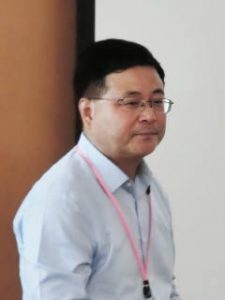 “I am very happy to be able to participate in this symposium. To give a brief introduction to the Institute of History at the Shanghai Academy of Social Sciences, its activities fall into three categories, with material published for each: 1) building a digital urban history lab combining the humanities and the sciences, 2) fine-grained research into Shanghai and its constituent components, and 3) research and praxis that contributes to the development of the city in the present. There is much we can learn from each other when it comes to research on the urban history of Shanghai and Osaka. I am confident that this symposium will prove to be of great significance as a collaborative research effort and I very much hope that we will continue to advance further opportunities for exchange.”
“I am very happy to be able to participate in this symposium. To give a brief introduction to the Institute of History at the Shanghai Academy of Social Sciences, its activities fall into three categories, with material published for each: 1) building a digital urban history lab combining the humanities and the sciences, 2) fine-grained research into Shanghai and its constituent components, and 3) research and praxis that contributes to the development of the city in the present. There is much we can learn from each other when it comes to research on the urban history of Shanghai and Osaka. I am confident that this symposium will prove to be of great significance as a collaborative research effort and I very much hope that we will continue to advance further opportunities for exchange.”
Zhang Zhihui
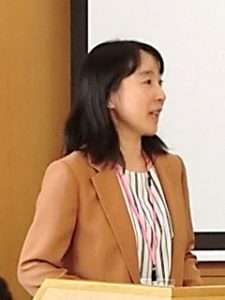 “Osaka City University is my alma mater, the point of departure for my career as a scholar, and so I am very happy to be able to participate in the symposium today at OCU. At Shanghai University we have worked enthusiastically to forge our exchange relationship with OCU. As part of that process, we were able to connect with the team at the Shanghai Academy of Social Sciences as well, further widening our circle of collaboration. Through these efforts, we have, without fail, benefitted tremendously from the insights of our colleagues in Japanese urban history. I look forward to making further headway together, both with this symposium and the many other opportunities for collaboration yet to come.”
“Osaka City University is my alma mater, the point of departure for my career as a scholar, and so I am very happy to be able to participate in the symposium today at OCU. At Shanghai University we have worked enthusiastically to forge our exchange relationship with OCU. As part of that process, we were able to connect with the team at the Shanghai Academy of Social Sciences as well, further widening our circle of collaboration. Through these efforts, we have, without fail, benefitted tremendously from the insights of our colleagues in Japanese urban history. I look forward to making further headway together, both with this symposium and the many other opportunities for collaboration yet to come.”
Special Session
In this session, Prof. Ma Xueqiang of the Institute of History at the Shanghai Academy of Social Sciences (SASS) gave a presentation entitled “The (Trans)Formation of a University and Its Neighborhood in Modern China: A Discussion of Shanghai’s Aurora University and Its Environs.”
Prof. Ma’s paper used the example of Aurora University in Shanghai (Ch: Zhèndàn Dàxué, 1903-1952) to provide a unique analytic perspective on the deep connection between the development of modern universities and transformations in urban context, examining the complicated and distinctive structure and functions of the modern city through an analysis of the Aurora’s founding and the (trans)formation of its neighborhood. In contrast to the typical growth of urban formations, cultural elements played the leading role in the formation of the university and its environs. The power immanent in culture itself, together with other elements that propel the evolution of urbanization, meshed with each other to form the university neighborhood’s spatial, social, and cultural structure. Simultaneously, it made the university the lynchpin of that process.
Prof. Ma’s presentation was composed of three sections: 1) From Xujiahui to Luwan Bay: Aurora’s Relocation, 2) A Multiplicity of Driving Forces: The Formation of a Distinct University Block within the French Concession, and 3) Aurora University and Its Environs: Internal Structure and Cultural Meaning. Through this analysis, he elucidated the distinctive “synthesis” and “complementarity” of the modern university district as well as how cultural education efforts gradually combined with urban planning and economic elements. Districts of this sort were anything but uniform in function, architecture, and social structure, instead clearly having unique characteristics. In short, one can say that they fostered a particular residential atmosphere and cultural significance centered on the university.
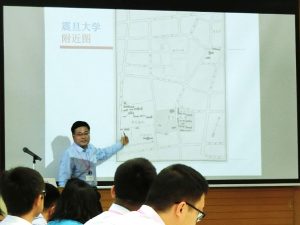 In the Q&A session, Prof. Ma was first asked where the sources he used in his research are held. In addition to those he collected in France, he drew on documents from the Shanghai Municipal Archives, archives for each city district, and university histories, etc. Next, in response to a question as to how Aurora acquired the site it moved to, he explained that while it was the Jesuit priest Ma Xiangbo (one of the university’s founders) who donated the land, whom Ma bought it from is unclear. A related question asked if individual land purchasing activities in Shanghai had anything to do with imperialistic acquisitions by the foreign concessions or, more generally, the global phenomenon of urban expansion in the twentieth century. Prof. Ma agreed that this was an important perspective and more research would be required. He noted that the expansion of the French Concession also proceeded in stages and that there is some evidence of a struggle over land rights between the university and the Church.
In the Q&A session, Prof. Ma was first asked where the sources he used in his research are held. In addition to those he collected in France, he drew on documents from the Shanghai Municipal Archives, archives for each city district, and university histories, etc. Next, in response to a question as to how Aurora acquired the site it moved to, he explained that while it was the Jesuit priest Ma Xiangbo (one of the university’s founders) who donated the land, whom Ma bought it from is unclear. A related question asked if individual land purchasing activities in Shanghai had anything to do with imperialistic acquisitions by the foreign concessions or, more generally, the global phenomenon of urban expansion in the twentieth century. Prof. Ma agreed that this was an important perspective and more research would be required. He noted that the expansion of the French Concession also proceeded in stages and that there is some evidence of a struggle over land rights between the university and the Church.
Next was a question about what connection there was (if any) between the fall of the Qing Dynasty and modernization, given that in Japan the real shift towards modernization came with the establishment of the Meiji government, whereas in the Chinese case the Qing were still in power in the period when Aurora University was founded, which also saw the expansion of foreign concessions and urban growth. Prof. Ma explained that while Aurora University was originally located in Chinese territory and the government’s influence over it may have weakened with the move to the French Concession, the governmental presence might simply have been thinner to begin with than in Japan. This would require further research. Next a participant asked where Chinese universities fall in terms of physical separateness from their environs, given the contrast between Japan, where universities are walled-off, and Europe, where they are not. Prof. Ma replied that in the case of Aurora University a wall was eventually built as the campus expanded. Noting that in Japan it is very common for religious bodies to establish universities, another participant asked whether it was the Catholic Church that founded Aurora. Prof. Ma confirmed that Aurora had strong religious ties.
In sum, the special session prompted a lively comparative discussion of China and other regions from the perspective of land and modernization that allowed for a deepening of mutual understanding.
Session I: Urban Space and Society – Part 1
The first session on urban space and society featured presentations from Saitō Hiroko (Kyoto Seika University), Wan Yong (SASS Institute of Applied Economics), and Ye Zhou (SASS Institute of History).
Saitō Hiroko: “Osaka Castle Garrison Commanders’ Residences (jōban yashiki) and Urban Society”
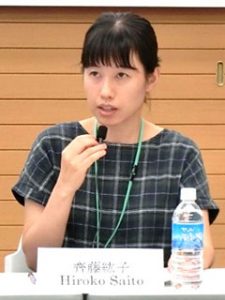 This presentation looked at the daimyo lords charged with providing security for Osaka castle, specifically the jōban, in order to explore the relationship between urban society and warrior residential areas (bukechi) during the second half of the seventeenth century. In Osaka, which came under direct rule of the bakufu in 1619 (Genna 5), the precincts of Osaka castle and the area surrounding it constituted the bukechi, where the castellan (jōdai; the shogun’s representative), along with the jōban and supplementary kaban (also chosen from among the daimyo), who shared responsibility for castle security, had their residential complexes. It also included the city magistrate’s office, and together the warriors and servants living there made up a considerable proportion of the city’s population. On the orders of the bakufu, the size of retainer retinues (i.e., the garrison) for daimyo posted to Osaka, along with the that of the residential area itself, were increased in the second half of the seventeenth century as the security arrangements for Osaka castle were systematized. For example, in 1648 (Keian 1) the post of jōban for the Kyōbashiguchi approach to the castle, which had gone unfilled for some time, was re-staffed—but this time as a two-man (i.e., two-location) system with yoriki and dōshin (lower-rank samurai composing the security force) added to the positions—and so the subresidences and barracks for each jōban were expanded. In 1661 (Kanbun 1) the jōban and the city magistrate were allowed to have their wives and children live with them and so jōban residences began to take on the character of lordly residential complexes (hantei). Additionally, the following year, the system of rotating castellans was abolished and Aoyama Munetoshi remained in Osaka as castellan with his retainer band on a long-term basis.
This presentation looked at the daimyo lords charged with providing security for Osaka castle, specifically the jōban, in order to explore the relationship between urban society and warrior residential areas (bukechi) during the second half of the seventeenth century. In Osaka, which came under direct rule of the bakufu in 1619 (Genna 5), the precincts of Osaka castle and the area surrounding it constituted the bukechi, where the castellan (jōdai; the shogun’s representative), along with the jōban and supplementary kaban (also chosen from among the daimyo), who shared responsibility for castle security, had their residential complexes. It also included the city magistrate’s office, and together the warriors and servants living there made up a considerable proportion of the city’s population. On the orders of the bakufu, the size of retainer retinues (i.e., the garrison) for daimyo posted to Osaka, along with the that of the residential area itself, were increased in the second half of the seventeenth century as the security arrangements for Osaka castle were systematized. For example, in 1648 (Keian 1) the post of jōban for the Kyōbashiguchi approach to the castle, which had gone unfilled for some time, was re-staffed—but this time as a two-man (i.e., two-location) system with yoriki and dōshin (lower-rank samurai composing the security force) added to the positions—and so the subresidences and barracks for each jōban were expanded. In 1661 (Kanbun 1) the jōban and the city magistrate were allowed to have their wives and children live with them and so jōban residences began to take on the character of lordly residential complexes (hantei). Additionally, the following year, the system of rotating castellans was abolished and Aoyama Munetoshi remained in Osaka as castellan with his retainer band on a long-term basis.
If we look at how the jōban daimyo households handled this inflation in their retainer bands, we find that starting from the Keian period in Osaka newly appointed jōban proactively engaged new retainers and servants, the latter including both those serving the jōban household directly as well as those kept by retainers resident in Osaka and the yoriki and dōshin. When it came to these activities, the bakufu had military concerns about the engagement of yoriki and retainers from lords west of the Kinki region, but when taking up their posts the jōban repeatedly sought leniency in this regard. In this way, masterless rōnin pooling in the Osaka region and yoriki (lit. “supplementary forces”) of gokenin status (bottom-ranking shogunal vassals) came to be incorporated into the jōban retainer bands. In this period rōnin and yoriki were a fluid class of persons who moved in and out of daimyo vassalship or yoriki status and rōnin condition (i.e., unemployment). With regard to the procurement of servants, policies permitting employment in and outside of fiefs were issued in the name of the shogun through the bakufu elders’ official edicts (rōjū hōsho). Direct hiring of servants by retainers and yoriki became commonplace, and there were even examples of the hiring process’s being contracted out to staffing agencies (kuchiireyado) in the city.
By examining the organization and composition of jōban retainers from dual perspectives—the castellan’s control of the castle precincts and the larger bukechi on the one hand and the magistrate’s administration of the commoner city on the other—we can see that the structure of the retainer band made regulation according to daimyo “house” or “clan” (ie) difficult. Since the retainer bands and the category of rōnin were both fluid, within the bukechi, too, fraternization between the former and the latter, who lived among the commoners, became an object of concern. In sum, Prof. Saitō’s presentation used the concrete examples described above to elucidate the structure of early modern Osaka’s garrison and the expansion of the bukechi from the perspective of urban social history.
Wan Yong: “Jiangnan within a City: On the Cultural Origins of Shanghai’s Old City and Its Spatial Characteristics”
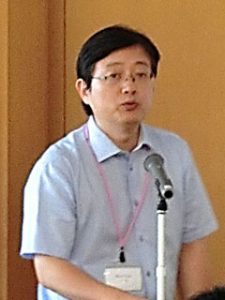 The area demarcated by Shanghai’s old fortifications are its “urban roots.” The foreign concessions spread out around the old walled city and developed from there. However, with this developmental boom and the urban dynamism it generated, people gradually forgot the importance of the old city and came to regard it as an obstruction and nuisance. In this presentation, Prof. Wan gave an analytical overview of the old city’s location and development over the long term, highlighting the cultural genes that have persisted through its history and examining just what an important place the old city holds in Shanghai’s developmental process.
The area demarcated by Shanghai’s old fortifications are its “urban roots.” The foreign concessions spread out around the old walled city and developed from there. However, with this developmental boom and the urban dynamism it generated, people gradually forgot the importance of the old city and came to regard it as an obstruction and nuisance. In this presentation, Prof. Wan gave an analytical overview of the old city’s location and development over the long term, highlighting the cultural genes that have persisted through its history and examining just what an important place the old city holds in Shanghai’s developmental process.
The old city did not originally have walls but became an exclusive space once they were built. The great and the good lived within them. It was only in the early twentieth century that the walls were dismantled and it became an open space again. The presence or absence of walls is an important problem. There are places where the walls came down as a result of damage in war. And there are also places where they came down due to the influence of real estate investment, destroyed in the course of new development projects. Lengths of wall that were taken down became roads. Similarly, within the old city there used to be many canals, but due to the emergence of hygienic concerns these were also filled in and transformed into roads.
Prof. Wan then turned to his examination of the spatial characteristics of the district encompassing the old city. Originally it had an organic construction, with a complex tangle of roads, but later these were systematized. If we compare the French Concession and the old city, their road networks were quite different, the latter having many of T- and Ł-shape.
Lastly, he offered some observations and recommendations as to the socioeconomic development of the old city area. At present, how to preserve the old city has become an issue of concern. Culturally significant buildings have survived in a concentrated area, so thinking carefully about how to pass them on to future generations is of great importance. He and his colleagues at the SASS are searching for solutions, such as the design of parks, and expect to be able to contribute to the future development of the old city area.
Ye Zhou: “City Structure and Fortification Repair in the Traditional Society of Shanghai”
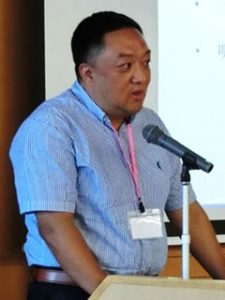 Through an examination of changes in fortifications in Ming- and Qing-Dynasty Shanghai, Prof. Ye’s research has shown that while the cities in the Shanghai area varied in scale and time of construction, they shared the same characteristics.
Through an examination of changes in fortifications in Ming- and Qing-Dynasty Shanghai, Prof. Ye’s research has shown that while the cities in the Shanghai area varied in scale and time of construction, they shared the same characteristics.
First, although the construction of these cities was informed by political and/or military considerations, it went ahead with the natural and geographic conditions of the relevant area in mind. As such, urban structures in each period were not very regularized, seldom taking the classic square form of Chinese political centers.
Second, in most canal cities, rather than fortifications’ shaping the urban structure it is the waterways and network of markets that shape the fortifications. Fortifications in the Shanghai area basically belong to the category of “fill-in” structures. Essentially, they were fitted into the pre-existing environment after the urban structure had been established. During construction of fortifications one has to take into consideration the existing waterways and urban spaces. When fortifications were built they did not destroy the existing system of waterways, but rather made extensive use of it, resulting in the complicated canal networks within the walls. Accordingly, we can say that urban structures in the Shanghai area were essentially determined by the course of rivers. The main roads within the walls naturally ran along the waterways. The main commercial areas likewise emerged organically with the development of economic activity along the waterside. Further, the development of commerce and transport and their rapid expansion to the surrounding area brought increasing prosperity to urban centers in Songjiang Prefecture, Shanghai County, and elsewhere.
Third, most of these cities were subject to wakō pirate attacks during the reign of the Ming-Dynasty Jiajing Emperor (1521-1567), which led to plans to construct large-scale fortifications. However, due to traditional society’s systems of local public works management and public finance, the construction of fortifications was neglected in many cases. This was also a cause of the relative weakening of the political functions in Shanghai-area city structures and of the departure from tradition in where government offices were constructed.
Q&A
First, a participant asked Prof. Ye to confirm that they were correct in having understood from his presentation that seats of government did not necessarily have fortifications, that in some cases they did not due to wakō attacks and various other circumstances (this understanding was correct). Another opined that from the perspective of socio-spatial research as practiced in Japan one would need to focus not only on the fortifications themselves, but on the people who built them and those who lived within them.
Prof. Saito was asked about where the sources she used in her presentation are held. She replied that copies of records composed by the jōban daimyo are preserved at Kyushu University, but their provenance prior to that acquisition has not been established. She was then asked what the nature of the relationship was between the commoners and those of warrior status. She noted that there has been a variety of concrete research in that area and offered the example of commoners hired to serve warrior households in the jōban residences.
A question was directed to Prof. Ye as to who was trying to maintain cities financially, what the distribution of money was between the center and the localities, and whether there were cases of wealthy merchants’ using their own money to repair and complete cities’ defenses. He explained that the central government was not involved in the construction and repair of local fortifications and that even in the provinces this was funded not through taxes, but out of pocket by local administrators in ninety percent of cases. In response to this, there was a comment that this problem should be addressed not through the binary of central administration and local administration, but by introducing regional societies themselves as third terms.
Overall, Session I resulted in a deep and meaningful discussion that reaffirmed the fact that in both Shanghai and Osaka the spaces constituted by cities had a profound relationship with the social forms constituted by the people who lived in them.
Session II: Urban Space and Society – Part 2
Continuing from Session I, Session II reprised the theme of urban space and society with presentations from Machida Tetsu (Naruto University of Education), Zhang Xiuli (SASS Institute of History), and Shimazaki Mio (UCRC Research Scholar, Marginal Social Groups Exchange Program Participant)
Machida Testu: “Domain Warehouses and the Regulation of Maritime Traffic in Osaka: Tokushima Domain and the Shikoku Pilgrimage Route in the Early Edo Period”
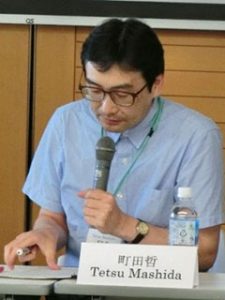 Great progress has been made in research on the warehouses (kurayashiki) maintained by every early modern Japanese domain in Osaka through the elucidation of their three defining aspects: not only did they serve as 1) facilities for the sale of domain tax rice, but also as 2) avenues for the realization of the city magistrate’s broad administrative and judicial authority in urban society, and as 3) magnetic poles for a host of societal relationships. In this presentation, Prof. Machida examined the movement of people and the regulation thereof as another function of the storehouse, which served an interface between the domain and Osaka.
Great progress has been made in research on the warehouses (kurayashiki) maintained by every early modern Japanese domain in Osaka through the elucidation of their three defining aspects: not only did they serve as 1) facilities for the sale of domain tax rice, but also as 2) avenues for the realization of the city magistrate’s broad administrative and judicial authority in urban society, and as 3) magnetic poles for a host of societal relationships. In this presentation, Prof. Machida examined the movement of people and the regulation thereof as another function of the storehouse, which served an interface between the domain and Osaka.
The Shikoku henro, a pilgrimage that provided training for lower-ranked religious practitioners, became a popular practice in the second half of the seventeenth century. What came to serve as a standard guidebook for the route was the Shikoku henro michishirube (1687), authored by the Buddhist practitioner Shinnen of Terashima in Osaka. Combining descriptions of the origins of the pilgrimage, the principal objects of worship at each sacred site, and instructions for making pilgrimage correctly, it guided many people along the Shikoku henro. To give an example of the advice it contained, “when looking to cross from Osaka to Awa Province for Shikoku Pilgrimage, if you go to Awaya Jinzaemon’s outfit in the third chō (block) of Edobori in Osaka, you can cross the sea for a fare of two monme.” At that time, boats for western Japan departed Osaka from set points and through set ferry operators (funayado) depending on the destination. Those bound for Awa left from Tanabeyabashi (the Tosabori-Jōanbashi area today) through the funayado Awaya (see Namba suzume [1679]).
From the guidebook’s description, it seems as though one could freely cross the sea just by showing up at the ferry operator. However, if we look at Tokushima domain (comprising Awa and Awaji Island) documents, things look quite different, for in the mid-seventeenth century, in response to the shogunate’s prohibition on Christianity, the domain had 1) carried out religious registration (though only recording heads of households) and, at the same time, had 2) begun regulating the entry of travelers and rōnin from other domains to prevent any influx of Christians into Tokushima.
Above all, the domain kept its eye on those crossing from Osaka (merchants and pilgrims). Already by 1657 the domain had mandated that all merchants and Shikoku henro pilgrims traveling to Awa from Osaka apply to the domain warehouse caretaker’s office (rusui) for a visa (kitte) permitting entry and passage through its territory. The caretaker’s office, wary of having to take responsibility if a traveler should cause problems, had introduced by 1687 at the latest an additional guarantor system that required its official contractors Awaya Jinzaemon and Shijiraya Yasōemon to vouch for travelers’ identity before a visa would be issued. In fact, by 1696 the domain had had the contractors station representatives in Tokushima to take total responsibility if a traveler got into trouble in Awa.
This system, established over the second half of the seventeenth century, of maritime traffic regulation by way of the Osaka warehouse caretaker’s visa lasted until the late eighteenth century, when the ōrai tegata system (passports issued at the traveler’s official community of residence through village temples, city neighborhood officials, etc.) became generalized across the country.
Zhang Xiuli: “Spatial Extension and Functional Transformation: Historical Changes to Shanghai’s Putuo District”
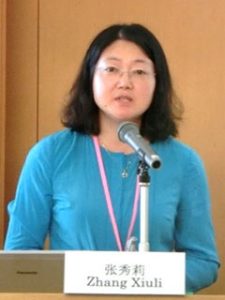 Putuo District is located on the northwest edge of downtown Shanghai and the changes it experienced encapsulate the story of the city’s development. For a long time it was a peri-urban area, but grew ever larger as the urban core of Shanghai expanded. Putuo’s urbanization began with the expansion of the International Settlement over the turn of the twentieth century. It became a formal administrative district in January of 1947, but at the time it comprised an area of only 2.65 km2. After 1949 it was expanded six times—with just over fifty square kilometers of land taken from Xinjing, Zhenru, Zhabei, Xijiao, and Dachang Districts, as well as from Baoshan and Jiading Counties—into a district composed of two sub-districts (Bangnan and Bangbei) totaling 55.53 km2, twenty times its original size. At its greatest extent, Putuo measures 12.5 km east-west and 8.3 km north-south.
Putuo District is located on the northwest edge of downtown Shanghai and the changes it experienced encapsulate the story of the city’s development. For a long time it was a peri-urban area, but grew ever larger as the urban core of Shanghai expanded. Putuo’s urbanization began with the expansion of the International Settlement over the turn of the twentieth century. It became a formal administrative district in January of 1947, but at the time it comprised an area of only 2.65 km2. After 1949 it was expanded six times—with just over fifty square kilometers of land taken from Xinjing, Zhenru, Zhabei, Xijiao, and Dachang Districts, as well as from Baoshan and Jiading Counties—into a district composed of two sub-districts (Bangnan and Bangbei) totaling 55.53 km2, twenty times its original size. At its greatest extent, Putuo measures 12.5 km east-west and 8.3 km north-south.
Putuo’s spatial expansion is closely connection with changes in its administrative function: from an industrial district (Hùxī gōngyèqū) in the Republican period, to a former industrial area under economic planning, and, since “reform and opening up,” to the distribution and trade center for West Shanghai, a commercial trading center, an “emerging district for business, trade, science, and technology;” an “implementation district for the promotion of progress through scientific and technical innovation,” and an “ease of living, movement, and entrepreneurship ecological district.” Putou District has changed its function ceaselessly, amalgamating different resources in response to the government’s demands. As a result, it is referred to by the Communist Party of China Shanghai Municipal Committee and the Shanghai Municipal People’s Government as the “Shanghai example of successful transformation of a former industrial district.”
Shimazaki Mio: “Night Soil Collection in Osaka Castle: An Examination of Peri-urban Connections through the Shigino Village Documents”
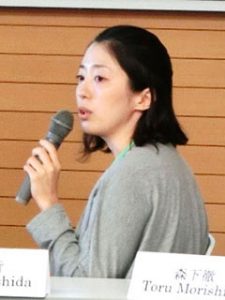 Shigino Village, in Higashinari County, Settsu Province, was located just northeast of Osaka Castle. The defining characteristics of the village archive are, first, that it is particularly rich in village administrative documents from the early seventeenth through early eighteenth centuries and, second, that it preserves sources pertaining to the handling of excreta (shimosōji) together in a single collection. Previous research on human waste disposal and transportation had mostly focused on the commoner areas of the city and not much was known about these matters within the massive Osaka Castle compound and its garrison of samurai. In this presentation Dr. Shimazaki used the Shigino documents to reconstruct as much as possible of the social structure of an agricultural village quite close to the city and elucidate its relationship with the warrior status groups stationed in Osaka Castle.
Shigino Village, in Higashinari County, Settsu Province, was located just northeast of Osaka Castle. The defining characteristics of the village archive are, first, that it is particularly rich in village administrative documents from the early seventeenth through early eighteenth centuries and, second, that it preserves sources pertaining to the handling of excreta (shimosōji) together in a single collection. Previous research on human waste disposal and transportation had mostly focused on the commoner areas of the city and not much was known about these matters within the massive Osaka Castle compound and its garrison of samurai. In this presentation Dr. Shimazaki used the Shigino documents to reconstruct as much as possible of the social structure of an agricultural village quite close to the city and elucidate its relationship with the warrior status groups stationed in Osaka Castle.
First, using the combined religious affiliation and population register (shūshininbetsu aratamechō) from 1685 (Jōkyō 2), she gave an overview of the village’s structure in the late seventeenth century: with 129 households across 65 holdings, landless commoners (mizunomi byakushō) made up about half the population. We can also see people in the registers who were attached to specific households, mostly those of village officials, recorded under various titles indicating subordination or servitude (fudai, meshitsukai fudai, etc.). Located on the lower reaches of the Yodo River, Shigino was prone to flood damage and so its arable area was not fixed, which likely prevented stable patterns of land ownership. Given these conditions for cultivation, the question naturally arises as to how residents’ livelihoods changed over time. However, since we find the names of a vegetable wholesaler in Temma and a freshwater fishmonger in Kyobashi among Shigino landholders, it is reasonable to assume that they participated in production and distribution mostly by making connections with merchants who supplied fresh groceries to the city.
As such, handling waste disposal for Osaka Castle was probably an important source of income for Shigino. The village collected waste from three sources: 1) the east and west ōbangashira (chiefs of the inner guard) stations, 2) the fourth kaban station, and 3) the east and west ōbanshu (inner guardsmen) stations. From the waste disposal contracts drawn up in the decades around 1700 we learn that it was villagers with five koku of land or less, along with the landless, who were responsible for the actual work. Further, as demanded by the castle regulations, the village was required to pledge not to convey merchandise, letters, or bribes. Evidently, the garrison units that contracted with the village for waste disposal thoroughly understood that the collected excreta was a high-value product: they leveraged that value by passing on the cost of straw for their stables to the contracted village and considering offers from different contractors as they arose.
In sum, through the introduction of examples grounded in the Shigino Village sources, this presentation offered a concrete reconstruction of the social relationships formed between Osaka Castle and its environs.
Q&A
Prof. Machida was asked if there were any actual cases of the guarantors’ having to take responsibility for problems that arose with travelers. He offered the example of travelers staying in Tokushima’s castle town. When they fell ill, the contractors’ representatives received instructions to provide treatment and send them back to Osaka. There was another question to Prof. Machida as to the motivations of people who made pilgrimage. He explained that the number of pilgrims increased with the publication of the guidebook and that there were increasing numbers of cases where people who could no longer eke out a living in villages turned to itinerant mendicancy.
Next, Dr. Shimazaki fielded a question about Osaka’s population in the period under discussion (the late seventeenth century) and hygienic conditions in the city. Osaka’s population, while not static, averaged about 300,000 people. The villages around Osaka worked out among themselves where each would collect in the common areas of the city and since Shigino did not have a monopoly on collection for the castle, it is highly likely that other villages were involved as well.
A participant suggested to Prof. Machida that there might be some similarities between the case he described and China’s Jiangnan region, where Mt. Putuo (an island) is an important site for Buddhist pilgrimage and the government also regulated maritime passage. He was then asked if the regulations reduced the number of travelers and explained that Tokushima domain understood that it would be undesirable to exert a negative influence on the pilgrimage route through indiscriminate regulation. They do not seem to have had any intention of abolishing the pilgrimage.
Another question was put to Dr. Shimazaki as to how villages decided which of them would be in charge of waste collection duty. She explained that proximity likely had a lot to do with it and that since the same villages performed the same duties year after year it seems as though collection privileges had become solidly territorialized. She was then asked if the government intervened (in the dispensation of these rights) as means of poor relief, but she explained that this was not the case; collection rights were sought and won by villages for their own interests. Finally, asked if this collection system was effective in terms of hygiene, she replied that since villages could lose their contracts for poor work they had to make sure it was done thoroughly.
In sum, Session II provided for deep discussion of the relationships between cities and the peripheries that enveloped them, as well as the movements of people that constituted those ties.
Day 2: 8 September (Sun) 9:30am-5:30pm
Session III: Urban Culture and Society
Session III featured presentations from Li Dongpeng (Shanghai Audio-Visual Archives), Kanda Yutsuki (Ochanomizu University), Wang Jian (SASS Institute of History).
Li Dongpeng: “Urban Records and Memories through the Documentary The Eighth Far Eastern Championship Games (1927)”
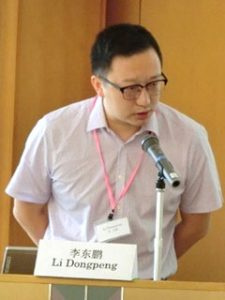 Almost immediately after their invention, the new technologies of photography and film became special media for the recording of urban change, used to record cityscapes, historical events, and ordinary people. Historical images have the virtue of being impactful, visual, and editable, imbuing them with the ability to make memory “come alive” and a distinctive value for researching cities’ transformation. The Far Eastern Championship Games, the predecessor to today’s Asian Games, were an early twentieth-century regional sporting event in which China, Japan, and the Philippines were the principal participants. Organized under the imprimatur of the Fédération internationale d’éducation physique (FIEP), the Games had a great deal of influence in international society. The documentary film The Eighth Far Eastern Championship Games was shot in Shanghai in 1927. Not only did it capture all the matches, but also, in detail, the city dwellers in the audience and urban landscapes. The film offers vivid and diverse visual primary sources for research in the urban history of modern Shanghai. Dr. Li’s research uses the film to examine the role and value of historical images for urban studies.
Almost immediately after their invention, the new technologies of photography and film became special media for the recording of urban change, used to record cityscapes, historical events, and ordinary people. Historical images have the virtue of being impactful, visual, and editable, imbuing them with the ability to make memory “come alive” and a distinctive value for researching cities’ transformation. The Far Eastern Championship Games, the predecessor to today’s Asian Games, were an early twentieth-century regional sporting event in which China, Japan, and the Philippines were the principal participants. Organized under the imprimatur of the Fédération internationale d’éducation physique (FIEP), the Games had a great deal of influence in international society. The documentary film The Eighth Far Eastern Championship Games was shot in Shanghai in 1927. Not only did it capture all the matches, but also, in detail, the city dwellers in the audience and urban landscapes. The film offers vivid and diverse visual primary sources for research in the urban history of modern Shanghai. Dr. Li’s research uses the film to examine the role and value of historical images for urban studies.
With historical images, we can judge the ages of the buildings that appear in them, which is a most important characteristic of these media. The grounds for the Games were located in the French Concession. The land was owned by the Rockefeller Foundation and the Americans had built a baseball field there with the intention of popularizing the game in Shanghai. It was a cultural space, with Aurora University and a hospital nearby. The film captures the streets around the grounds and passersby, allowing us to get a sense of the contemporary cityscape. In the footage of the events themselves we can find a number of famous people among the participants, whom we can identify by cross-referencing with the newspapers of that time.
This film of the Eighth Far Eastern Championship Games is a historical source unto itself. The footage of the world it captures is accompanied by the narrator’s interpretation. For that reason, we must approach the use of film sources with care.
Kanda Yutsuki: “Plays and Livelihoods in Early Modern Osaka: On the Business of Costume Lending”
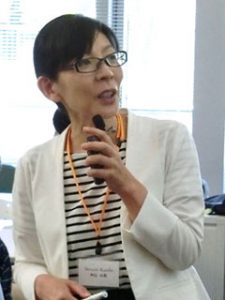 Early modern performing arts, though thoroughly commodified through the kōgyō system of show business, also became a magnetic pole of consumer culture that gave shape to a network of livelihoods, from the craftspeople and merchants directly and indirectly involved in the industry to teahouses and publishers. In this presentation, Prof. Kanda provided an introduction to those lives and livelihoods that enveloped the performing arts, focusing on merchants who operated costume rentals (kashiishō).
Early modern performing arts, though thoroughly commodified through the kōgyō system of show business, also became a magnetic pole of consumer culture that gave shape to a network of livelihoods, from the craftspeople and merchants directly and indirectly involved in the industry to teahouses and publishers. In this presentation, Prof. Kanda provided an introduction to those lives and livelihoods that enveloped the performing arts, focusing on merchants who operated costume rentals (kashiishō).
The specific subject of her talk was a dispute involving costume rentals that occurred in Osaka in 1827 (Bunsei 10). As plays (shibai) and playgoing spread across the country, costume rental business appeared. In the Kikuyamachi neighborhood, which bordered Osaka’s main theater district of Dotonbori, there was a man named Ikedaya Gensuke. In 1827, Gensuke rented out 216 costumes for a play put on in the Itami area; however, eighty-seven were not returned. As such, Gensuke filed suit with Osaka’s city magistrate against Komeya Kyūbē and four others. After a confrontation between Gensuke and the defendants, seventy-one costumes were returned, but the last sixteen remained unaccounted for. As a result of the magistrate’s inquiries, costumier (ishōkata) Izumiya Chūemon of the eighth neighborhood block of Nishigōzu-shinchi and one Kichibē residing with Imagawaya Seikichi of Hoteichō were taken into custody, the missing costumes located, and the incident resolved (See Kikuyamachimonjo 211).
Itami was a semi-urbanized village (zaigōmachi) located about seven kilometers northwest of Osaka, and there were small playhouses lining the road from Itami to Ikeda. Theater programs survive, though they date from after the Bunsei period, and we can see that evidently the playhouses there rented costumes from Osaka.
It is noteworthy that not just a person from Itami, but also one from Gōzu in Osaka were involved in the incident. Gōzu was a neighborhood where costumiers lived. What appeared to be a fraud perpetrated by the man from Itami actually involved someone in the same industry in Osaka as well. There is a possibility that the Itami man and the Gōzu man were in cahoots.
In this way, as show business areas proliferated, various new relationships were created in Osaka and its periphery among the trades involved in the theater.
Wang Jian: “Popular Religion along the Banks of the Wusong River in Modern Shanghai”
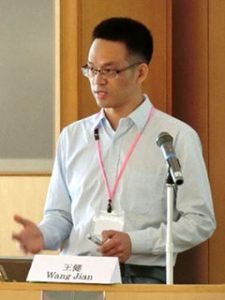 The Wusong River (Suzhou Creek) and the Huangpu River are regarded as mother waters in Shanghai and have played an important role in the historical development of the city. Many scholars have made this the focus of their research, and popular religion especially has been an entry point for studies of the relationship between the Wusong and the development of modern Shanghai.
The Wusong River (Suzhou Creek) and the Huangpu River are regarded as mother waters in Shanghai and have played an important role in the historical development of the city. Many scholars have made this the focus of their research, and popular religion especially has been an entry point for studies of the relationship between the Wusong and the development of modern Shanghai.
Building on previous work on the faiths of the sea and water gods, as well as the god of wealth as practiced along the banks of the Wusong, Prof. Wang’s research sheds light on how popular religion changed in response to environmental, social, and economic transformations and local experiences of modernization. The effects of these shifts showed up in various ways, from changes in who funded temple construction, addition and omission in myths and legends, and the content of religious activities themselves. Through his research, Prof. Wang is aiming not only to elucidate the complicated connection between faith and local society, but also to offer a richer, more complex perspective on change in social structures in the riparian area and a deeper understanding of the multi-dimensionality of modern Shanghai’s urban development.
Q&A
Prof. Wang had discussed how the construction of a temple on the north side of the river led to people of the lower classes taking up residence there, and so was asked why the south bank had already been developed and the north had not. He explained that the land used for the temple had been reserved for a railway but was put to another use when the planned construction did not take place in that specific location.
Next there was a question for Prof. Kanda as to whether there were any other theater districts in Osaka besides Dotonbori. She explained that there were also concentrations of playhouses on the grounds of temples and shrines and newly developed areas such as Sonezaki. She was then asked for more details on in what situations the services of the merchants and craftspeople involved in the theatre would be called upon. Generally, costumes and wigs could be used for all types of plays, but props, scenery, and signboards varied from case to case.
Prof. Wang was asked for confirmation regarding the name of Wusong River, which goes by the characters for “Suzhou River” in Japanese.
The next question was for Dr. Li: while film excites the imagination, it also has the ability to entrench stereotypical views of history, as with protests in Japan on the sixtieth anniversary of the Japan-US Security Treaty (Anpo). Would it not be more appropriate to consider the positive aspects of film alongside these negatives? Dr. Li replied that the film itself emphasizes buildings, which can serve as objective markers, but also agreed that political distortions do end up in film and that there is a need to maintain a rigorous distinction between subjectivity and fact, and to pay close attention to how film is edited.
The final question was again put to Dr. Li. The questioner, noting that in Japan, until relatively recently, the prevailing image of China was downtown Shanghai, wanted to know what was distinctive about Shanghai in comparison to other localities. Dr. Li explained that most of the footage of old China taken outside Shanghai was lost during the war. Presently only a bit survives but the search for more is ongoing and has been taken up worldwide.
In sum, Session III allowed for an in-depth discussion of everyday life and society as they related to the diverse cultural forms of religion, performing arts, and film.
Session IV: Cities and the World of the Masses
Session IV was organized around the theme of urban lives of ordinary people, with presentations from John Porter (Tokyo University of Foreign Studies), Mou Zhenyu (SASS Institute of History), and Iida Naoki (Osaka Museum of History).
John Porter: “Poor Relief and Local Society in Osaka from the Middle to Late Edo Period”
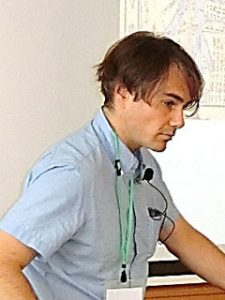 In his presentation, Prof. Porter used the documents of the Kobayashi family (Kobayashi-ke monjo; held by the Osaka Municipal Central Library) to examine almsgiving (segyō) in the commoner areas in mid to late Edo-period Osaka, specifically, the fifth and sixth neighborhood blocks (chō) of Oikedōri area over the latter half of the eighteenth century and the first half of the nineteenth. His aim was to lay out the basic structure of the system of urban poor relief and shed light on the various social relationships that supported it. Poor relief in early modern Osaka was organized at the level of individual chō, that is, within systems of place-based communal connections. When hardship was widespread, public authorities relied on the grasp these self-governing neighborhoods had on local conditions, implementing top-down relief on the basis of information they provided. As such, Prof. Porter focused on the relationship between local communities—one of the main vehicles of relief activities in urban society—and the subjects of those activities, that is, the urban poor, giving a brief description of how they were constituted historically. On that basis, he elucidated the sort of social mechanisms through which relief was realized and then considered the distinctive structural features of segyō and gōryoku in Oikedōri.
In his presentation, Prof. Porter used the documents of the Kobayashi family (Kobayashi-ke monjo; held by the Osaka Municipal Central Library) to examine almsgiving (segyō) in the commoner areas in mid to late Edo-period Osaka, specifically, the fifth and sixth neighborhood blocks (chō) of Oikedōri area over the latter half of the eighteenth century and the first half of the nineteenth. His aim was to lay out the basic structure of the system of urban poor relief and shed light on the various social relationships that supported it. Poor relief in early modern Osaka was organized at the level of individual chō, that is, within systems of place-based communal connections. When hardship was widespread, public authorities relied on the grasp these self-governing neighborhoods had on local conditions, implementing top-down relief on the basis of information they provided. As such, Prof. Porter focused on the relationship between local communities—one of the main vehicles of relief activities in urban society—and the subjects of those activities, that is, the urban poor, giving a brief description of how they were constituted historically. On that basis, he elucidated the sort of social mechanisms through which relief was realized and then considered the distinctive structural features of segyō and gōryoku in Oikedōri.
Proceeding through an analysis of the sources, he made the following two observations: first, as above, the system of urban poor relief was organized, as above, with chō communities as its pillars and these functioned, alongside large merchants, as the front line providers. To supplement this private charity in times of general distress, the bakufu implemented public relief efforts. In such circumstances, the connection between individual poor people and public authority was mediated by these communities, relief rice being distributed through the offices of chō officials.
Second, this temporary public relief was directed at those poor people on the brink of falling into beggarhood, with the objective of preventing them from having to abandon their communities. Those poor people who were actually reduced to homelessness (mushuku) fell under the jurisdiction of the formally organized beggar status groups (hinin). The public relief (osukui) in the seventh year of Tenmei (1787) was provided explicitly to prevent this outcome, so we can reasonably surmise that recipients were not the destitute generally, but only those at risk of falling out of their chō.
Mou Zhenyu: “An Examination of Land Prices in Shanghai’s French Concession during the Republican Period (1924-1941)”
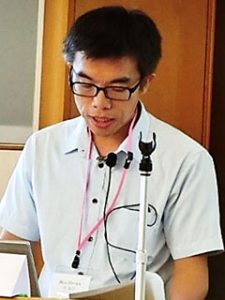 In his paper, Dr. Mou drew on land registers, maps, and associated documents compiled by French authorities to reconstruct, using GIS, the geographic distribution of land prices (for 1924, 1928, 1932, 1934, and 1941) in order to to analyze the movement of prices in the Concession through time and space. The main point of inflection in the temporal dimension is the Second Sino-Japanese War. 1) Before the war, land prices in the Concession exhibited growth across the board, with 1928-1934 in particular (labelled Shanghai’s golden age by Western scholars) as the period showing the most rapid increase. After 1932, however, the January 28 Incident and the silver crisis of 1934-1935 caused appreciation to slacken and we see conditions of zero or negative growth. 2) With the outbreak of war with Japan in 1937, displaced people descended on the Concession while factories and shops also relocated there, prompting a significant rise in land prices in its central and western areas, though not at the rates of the prewar period.
In his paper, Dr. Mou drew on land registers, maps, and associated documents compiled by French authorities to reconstruct, using GIS, the geographic distribution of land prices (for 1924, 1928, 1932, 1934, and 1941) in order to to analyze the movement of prices in the Concession through time and space. The main point of inflection in the temporal dimension is the Second Sino-Japanese War. 1) Before the war, land prices in the Concession exhibited growth across the board, with 1928-1934 in particular (labelled Shanghai’s golden age by Western scholars) as the period showing the most rapid increase. After 1932, however, the January 28 Incident and the silver crisis of 1934-1935 caused appreciation to slacken and we see conditions of zero or negative growth. 2) With the outbreak of war with Japan in 1937, displaced people descended on the Concession while factories and shops also relocated there, prompting a significant rise in land prices in its central and western areas, though not at the rates of the prewar period.
As regards the spatial dimension, land prices sloped downwards from their peak at The Bund (Waitan) and Xiafei Road, from the central area to the margins, east to west, and north to south. High prices propagated outwards from this center with the construction of roads. Dr. Mou observed three important factors at work in the growth of land prices: large investments of both outside and local capital created a bubbling real estate market as an intrinsic driver of growth. Next, as the fundamental driver, there was the war and the image of the Concession as a safe space, which made Shanghai into a population catchment, with unbroken population growth and demand for housing driving up land prices. Finally, improvement of infrastructure and the organization of transport providers constituted another important force pulling up prices.
Iida Naoki: “Foundlings and Orphanages in Meiji-period Osaka through Two Aiiku Societies”
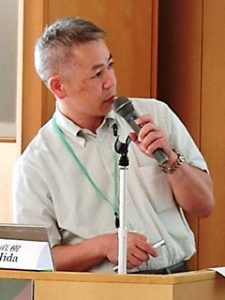 Dr. Iida’s presentation discussed the management of orphanages in Osaka during the Meiji period (1868-1912) and the lives of the urban lower classes who took in and raised children from such institutions. Specifically, he looked at the Aiikusha (“society for loving child-rearing”; founded 1880), which is known as “the first private institution for care work in Osaka City,” and its branch in Sakai (founded 1886), the Aiikusha for Osaka Prefecture (Osaka-fu shiritsu Aiikusha). Previous research has relied on the work of Hirata Takao to characterize these institutions, but their actual management has not been described in sufficient detail.
Dr. Iida’s presentation discussed the management of orphanages in Osaka during the Meiji period (1868-1912) and the lives of the urban lower classes who took in and raised children from such institutions. Specifically, he looked at the Aiikusha (“society for loving child-rearing”; founded 1880), which is known as “the first private institution for care work in Osaka City,” and its branch in Sakai (founded 1886), the Aiikusha for Osaka Prefecture (Osaka-fu shiritsu Aiikusha). Previous research has relied on the work of Hirata Takao to characterize these institutions, but their actual management has not been described in sufficient detail.
In an administrative order of March, 1880, Osaka Prefecture approved the founding of the Aiikusha and encouraged all county and city district offices to entrust it with the care of abandoned children. Informing the issuance of the order may have been the abolition of chō communities as administrative units with the Meiji government’s Three New Laws for Localities (Chihō sanshinpō) of 1878. We can thus say that the Aiikusha received official approval on the understanding that it would take over the function of caring for foundlings from the chō.
The original Aiikusha was dissolved in 1888, which likely had to do with the evacuation of children from the institution by Minami District in Osaka in response to reports of “cruel” treatment and educational methods. The institution had practiced, among other things, “withdrawal” of children’s food and clothing and “closet”ing them in a pickle cellar that had been the holding cell of a former police station. Of the thirteen children registered at the institution that year, five died before the removal took place.
The Aiikusha for Osaka Prefecture (AOP) was established in Sakai to provide for the rearing of foundlings and orphans aged thirteen and under. From 1894 it was entrusted with municipal funds for the care of children by the chief officials of Osaka City’s Minami, Nishi, and Higashi Districts; such was the strength of this connection, there were even times when it maintained an office in the city.
In 1911 the AOP was inspected by the noted businessman Hara Taneaki, who issued a damning criticism of the high death rates of children under its care, the unusual amount of tasks assigned to them, and the long hours of labor, which he called “child abuse.” These conditions were apparently the norm, for in 1908 the AOP was asked by the Alliance of Osaka Charities (Osaka jizen dōmeikai), in which the former was enrolled, to withdraw from the organization.
Some of the Aiikusha’s wards were taken in and raised by foster parents. According to an investigation by the police in 1911, there were sixty-three children who had been taken in by “caretakers” in Osaka City for between one yen and four yen, fifty sen per month. Many of these “caretakers” were recorded as living in Nipponbashi, an area known for its poverty, and working as rickshaw pullers or longshoremen, occupations held by the lower classes.
These poor households likely took in foundlings in order to gain the “rearing fee” as an income and with the expectation that they would provide supplementary labor to the foster family as they matured. As an example, Dr. Iida introduced the case of Takatsu Shizuko, one of the above sixty-three children, who lived in Higashisekiya-cho and was taken in by a family of bamboo pipemakers (rauya).
Q&A
Regarding the connection between the abolition of chō communities as administrative units, Dr. Iida was asked if there were not any sources of welfare provision besides the chō, as in China, where the wealthy fulfilled that function, local communities as such were not involved, and even the institutions known as yùyīngtáng were established through donations from the rich. Dr. Iida explained that Ōno, the Aiikusha’s founder, solicited donations from local notables to cover the organizations operating expenses, which might have similarities to the Chinese case, and that there were also care facilities established by Osaka Prefecture. In response to this discussion, an opinion was offered about the Edo-period chō, namely, that their central role in society and administration was less a matter of their own initiative and more due to the bakufu’s creating a system that imposed responsibilities on them and its reliance on them for the provision of poor relief. In response to this, Prof. Porter gave an example from Edo where the government mandated that the chō pay to set up their own rice reserve storehouses, which also provided low-interest loans and temporary poor relief.
Next, a question was directed to Dr. Mou about how Shanghai compared to Osaka, where in the 1930s overcrowding in the central part of the city led to population decline as people left for the margins. He explained that there were similar outflows to the outskirts of Shanghai as well. Asked if there were any other notable trends besides those mentioned in the presentation, he described, first, how the government policy was also a factor, as investment was not simply free and open to anyone, and noted, second, that while it is often supposed that land prices in the French Concession declined in wartime, they in fact doubled. It was also suggested that there was probably a difference between official and actual prices and that any consideration of land should look not only at buying and selling, but also at rents and letting.
Overall, Session IV made for a lively discussion involving comparisons between China and Japan through the lenses of land prices and population trends in cities, and the problems of assistance for the masses that lived in them.
Session V: Sources and Possibilities for Comparative History and Collaborative Research
Session V took up the themes of comparative history and opportunities for scholarly collaboration, with presentations from Zhang Zhihui (Shanghai University), Watanabe Kenya (OCU), Peng Hao (OCU), and Zhu Hong (Shanghai University)—all researchers versed in both Japanese and Chinese sources.
Zhang Zhihui: “Land Investments by the Japanese Government in Prewar Shanghai: On Problems Attending the Purchase of a Site for the Institute of Natural Sciences in Shanghai”
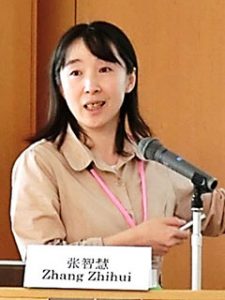 In the 1920s, the Japanese government, along with Britain and the United States, began to develop cultural projects in China using the indemnity paid by the Qing government. Planning the establishment of the Institute of Natural Sciences in Shanghai was an important part of the “Eastern cultural initiatives” then being advanced by the Japanese government, which dispatched Foreign Ministry officials with orders to purchase a site for the institute. With the cooperation of the Japanese consulate in Shanghai, Japanese enterprises, the departments of land for both the Shanghai Municipal Council and the French Concession, as well as British real estate agents, these officials conducted a detailed survey of available land in Shanghai and selected a number of candidate sites.
In the 1920s, the Japanese government, along with Britain and the United States, began to develop cultural projects in China using the indemnity paid by the Qing government. Planning the establishment of the Institute of Natural Sciences in Shanghai was an important part of the “Eastern cultural initiatives” then being advanced by the Japanese government, which dispatched Foreign Ministry officials with orders to purchase a site for the institute. With the cooperation of the Japanese consulate in Shanghai, Japanese enterprises, the departments of land for both the Shanghai Municipal Council and the French Concession, as well as British real estate agents, these officials conducted a detailed survey of available land in Shanghai and selected a number of candidate sites.
However, negotiations with the various land owners did not go smoothly and many obstacles arose. Persistence was rewarded, however, when at the end of 1924 they finally managed to purchase nine-acres (55 mu) of property located in the French Concession that belonged to the wife of Swedish-British shipping magnate Eric Moller. What is noteworthy here is that even after achieving its goal the Japanese government continued trying to buy up land around this site. By February, 1927, after two such successful purchases, its holdings totaled more than 100 mu. Japan’s investments in Shanghai were eventually subject to seizure by the French Concession’s department of land; nevertheless, the government continued to work to advance the enormous interests behind the purchases. By looking at the multiple negotiations and struggles behind the investment efforts, the complex layering of local interests and international relationships in 1920s Shanghai comes into sharp relief.
Watanabe Kenya: “Ke Shaomin’s New History of the Yuan in International Affairs”
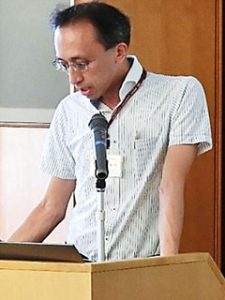 In China, when one dynasty fell the next dynasty compiled the history of its predecessor in edited volumes. Before the Tang dynasty these books were usually the product of single authors and are referred to as sīzhuàn (“private selections”); from the Tang onwards, new regimes established bureaus of history and mobilized great numbers of personnel for the compilation process (guānxiū, or “official editing”), the products of which are called zhèngshǐ. Collectively, these works, stretching from Sima Qian’s Records of the Grand Historian through the History of Ming, are known as the “Twenty-Four Histories.”
In China, when one dynasty fell the next dynasty compiled the history of its predecessor in edited volumes. Before the Tang dynasty these books were usually the product of single authors and are referred to as sīzhuàn (“private selections”); from the Tang onwards, new regimes established bureaus of history and mobilized great numbers of personnel for the compilation process (guānxiū, or “official editing”), the products of which are called zhèngshǐ. Collectively, these works, stretching from Sima Qian’s Records of the Grand Historian through the History of Ming, are known as the “Twenty-Four Histories.”
Despite the characters, zhèngshǐ does not imply these works are “correct history;” rather they represent “orthodox history” for the regimes that compiled them. In other words, they were intended to secure the legitimacy of the current dynasty’s taking up the mantle of its predecessor. As such, it was often the case that editing was shaped by political considerations.
Prof. Watanabe’s presentation focused on Ke Shaomin’s (1850-1933) New History of the Yuan. Ke, whose literary name was Fengsun, was from the Lai/Jiao Prefecture-area in Shandong Province and passed the imperial court examinations for jinshi in the twelfth year of the Guangxu Emperor’s reign (1886). The New History of the Yuan was a history of China under Mongol rule during the thirteenth and fourteenth centuries. His aim was to re-edit the History of Yuan, which was considered to be unreliable, and finally completed it in the Republican period. In december of 1919 President Xu Shichang designated Ke’s work an “orthodox history” (which are referred to as the “Twenty-Five Histories” when including the New History of the Yuan). In November of 1923, treating New History of the Yuan as his dissertation, Tokyo Imperial University awarded Ke a PhD, the first-ever instance of the university’s granting a degree to a foreigner on the basis of a doctoral dissertation. This much is common knowledge, but the background and significance of this decision has not been examined.
Prof. Watanabe’s research puts these basic facts about the New History of the Yuan in the context of the international situation. He approached the problem of why Ke Shaomin was awarded a PhD from Tokyo Imperial through diplomatic documents to determine how the decision was arrived at. He was able to conclude that the awarding of the degree was part of the Hara government’s conciliatory line on international affairs, intended to help set Japan’s relations with the Republic of China on a new footing. In closing, he suggested that the afterlives of books might hold possibilities for collaborative research efforts.
Peng Hao: “The Kaisho System and Urikominin in the Edo-period Nagasaki Trade”
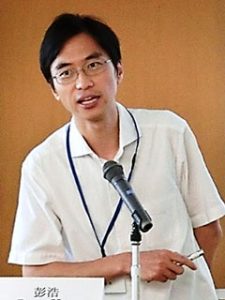 Nagasaki was Japan’s most important trading port in the Edo period, the only legal port of trade for foreign vessels from the promulgation of the sakoku edict in the 1630s until the establishment of the treaty port system in the middle of the nineteenth century. In terms of the limitation of where trade could take place, the Nagasaki trade had much in common with the mostly contemporaneous Canton trade. In the case of the latter, the historical sources most often used in research are Qing central government documents and Western documents. By contrast, in the case of the Nagasaki trade, the abundance of local sources is distinctive. In this presentation, Prof. Peng gave an overview of the system of trade at Nagasaki and, as an example of the results of his latest empirical research, of the various roles played by urikominin, the local Nagasaki merchants licensed to sell specific export products to foreign merchants.
Nagasaki was Japan’s most important trading port in the Edo period, the only legal port of trade for foreign vessels from the promulgation of the sakoku edict in the 1630s until the establishment of the treaty port system in the middle of the nineteenth century. In terms of the limitation of where trade could take place, the Nagasaki trade had much in common with the mostly contemporaneous Canton trade. In the case of the latter, the historical sources most often used in research are Qing central government documents and Western documents. By contrast, in the case of the Nagasaki trade, the abundance of local sources is distinctive. In this presentation, Prof. Peng gave an overview of the system of trade at Nagasaki and, as an example of the results of his latest empirical research, of the various roles played by urikominin, the local Nagasaki merchants licensed to sell specific export products to foreign merchants.
The heart of the operations of the trade was the Nagasaki kaisho. It was established by order of the bakufu at the end of the seventeenth century and served to mediate between foreign and domestic merchants until the mid-nineteenth century. In the case of imports, it bought up the cargoes of foreign merchants (chiefly Chinese and Dutch) in their entirety and then sold the goods on to various domestic merchants. Exports were collected at the kaisho before being handed over to the foreigners, but this required cooperating institutions and merchants. Copper was obtained through the Osaka copper guild (dōza) and specialty maritime products (e.g., dried abalone and sea cucumber, shark fins) through the tawaramono yakusho (“office for baled goods”). Other products were handled by merchants designated by the Nagasaki magistrate, i.e., the urikominin.
The term urikominin is relatively well known as it applies to the sales agents to the Dutch trading factory on Dejima (Dejima shoshiki urikominin), but in fact, from the same documents that attest to the Dejima urikominin, it has recently been shown that there were urikominin for the Chinese trade as well. In the late seventeenth century, with the end of the Qing’s maritime bans, the number of Chinese trading vessels arriving in Nagasaki increased dramatically and the resulting outflow of silver and copper became a serious problem for the bakufu. In response, the bakufu first limited the total annual amount of the trade and number of ships, and then, to clamp down on smuggling, introduced a policy that required Chinese resident in Nagasaki to live in an isolated compound called the tōjin yashiki. Subsequently, the regulation of the export trade began in earnest, with goods other than copper and specialty maritime products (i.e., shoshiki) entrusted to the urikominin.
With the Canton trade, the “Thirteen Hongs (Factories)” served as the government’s designated intermediaries and mǎibiàn (compradors) assisted the Western merchants with their purchasing. In terms of function, the former is similar to the Nagasaki kaisho and the latter to urikominin. However, we can observe differences in terms of how trade was approached and how it was managed in practice, and these were likely grounded in the different conditions of trade in the two countries.
Zhu Hong: “Modern Chinese International Students and Sino-Japanese Medical Exchange through the Lens of the Tokyo Imperial University Medical School (1927-1944)”
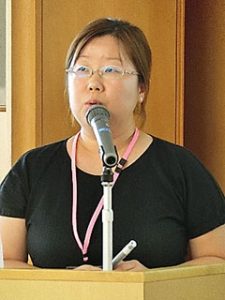 An enormous body of research, including source discoveries, has grown up on the subject of modern Chinese international students in Japan. The most important trend in recent research on the history of these international students has been the steady broadening of the objects of analysis to include students of science, engineering, art, and military science alongside those in the humanities. However, the same cannot be said for students of medicine, about whom research remains limited. Due to limitations in their ability to collect sources, Chinese scholars have mostly focused on the activities of medical students in Japan after they returned to China. Japanese researchers, for their part, have focused their attention on the activities of Chinese students in Japan at such institutions as Tokyo Women’s Medical Professional School and Chiba Medical College. Research on Chinese students at the apex of medical education in Japan, i.e., Tokyo Imperial University Medical College (TIUMC), remains thin.
An enormous body of research, including source discoveries, has grown up on the subject of modern Chinese international students in Japan. The most important trend in recent research on the history of these international students has been the steady broadening of the objects of analysis to include students of science, engineering, art, and military science alongside those in the humanities. However, the same cannot be said for students of medicine, about whom research remains limited. Due to limitations in their ability to collect sources, Chinese scholars have mostly focused on the activities of medical students in Japan after they returned to China. Japanese researchers, for their part, have focused their attention on the activities of Chinese students in Japan at such institutions as Tokyo Women’s Medical Professional School and Chiba Medical College. Research on Chinese students at the apex of medical education in Japan, i.e., Tokyo Imperial University Medical College (TIUMC), remains thin.
Making full use of both Chinese and Japanese primary sources, Prof. Zhu’s paper aimed to create a total picture of the Chinese students at TIUMC between 1927 and 1944, the content of their education, and their activities after returning home. First, using the Registry of Students in Japan (Ryūnichi gakusei meibo; editions 1-18) published by the Japan-China Educational Association, she compiled an integrated database of Chinese international students. By indexing them by place of origin, (departmental) affiliation, type of scholarship, and sex she created a comprehensive picture of enrollment at TIUMC. Next, using sources such as Tōkyō teikoku daigaku ichiran and Tokyo daigaku hyakunenshi (shiryō-hen), she looked at the program of Western medical education Chinese graduates of TIUMC received. Lastly, by organizing and analyzing a panoply of Chinese-language medical publications (e.g., Tóngrén yīxué, Yīxué zhīshí, Zhōnghuá yàoxué zázhì, Yīshì gōnglùn), she traced the activities of Chinese TIUMC graduates after they returned to China. Some served in the army as battlefield doctors while others spread Western medicine from positions at schools, hospitals, and research institutes. It is fair to say that, through multiplicity of channels, they contributed greatly to Sino-Japanese medical scientific exchange and the development of Western medicine in China. By shedding light on these interconnected issues, Prof. Zhu hopes to contribute to the creation of a comprehensive picture of the history of international medical students in Japan.
Q&A
The first question was for Prof. Zhang regarding how the different sources of money that appear in her sources were used. She explained that many currencies were used in Shanghai during this period (dollar, taels, yuan), but that she had not looked into this issue in any detail.
Next, Prof. Peng answered a question about the China-Nagasaki trade relationship after 1840, reiterating that he believes the Japanese urikominin were similar in nature to the Chinese mǎibiàn, although there is still much we do not know.
There was another question for Prof. Zhang, this time regarding how much higher the actual purchase price was than the publicly listed price in the negotiations. She explained that the illegal fees tacked on during negotiations were a major reason that they failed for so long. She added that the Japanese were finally able to make the acquisition because the owner was in financial difficulties and the foreign ministry officials took charge of the negotiations.
Prof. Watanabe was asked if Ke Shaomin was in fact a talented scholar and he explained that while we do not know the true standard of evaluation, the thinking at Tokyo Imperial was that the university was “recognizing great efforts.” Asked if they had deliberately chosen a pro-Japanese individual to grant the degree to, Prof. Watanabe confirmed that was indeed the case. As to what the Chinese side was doing in response to the Japanese activities with respect to the New History of the Yuan, there was not much of a reaction and the whole thing was probably not well regarded in China.
Through the lenses of diplomacy, trade, and international students, Session V stimulated an important discussion that took up research using both Chinese and Japanese sources in order to probe the possibilities for enriching such scholarship in both countries.
Concluding Remarks
To conclude the symposium, Inoue Tōru, Tsukada Takashi, Ma Xueqiang, and Zhang Zhihui gave comments reflecting on the two days of presentations and discussion.
Inoue Tōru
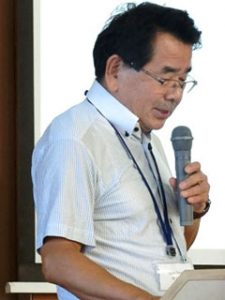 “If I had to distill the insights we have gained through our research in urban history here at Osaka City University, I would say that cities can be divided into traditional and modern forms. Traditional cities vary widely depending on where they are located. Surely we have been able to observe these differences, through the comparison of Osaka and Shanghai, over the past two days, and I believe this symposium has set a higher standard for research in both China and Japan.
“If I had to distill the insights we have gained through our research in urban history here at Osaka City University, I would say that cities can be divided into traditional and modern forms. Traditional cities vary widely depending on where they are located. Surely we have been able to observe these differences, through the comparison of Osaka and Shanghai, over the past two days, and I believe this symposium has set a higher standard for research in both China and Japan.
“As for the modern cities, my impression is that both Osaka and Shanghai have inherited and maintain the essential elements of their traditional urban formations. However, the presence of the French Concession in Shanghai, in which we see at work the process of the West’s absorption of Asia into capitalism, is a problem that cannot be explained solely within the framework of the continued evolution of the traditional city. How the ordinary masses living in such a city encountered the wave of modernity is a question I now feel myself wanting to explore in greater depth.
“With Session V’s foregrounding of research and methods distinct from urban history proper, I believe we have broadened our horizons even further. Our scholarship can only benefit if, for example, when debating theories of urban history, we take chances with comparison, with us here in Japan including comparisons with Shanghai in our presentations and talks, and vice versa for our colleagues in Shanghai.”
Tsukada Takashi
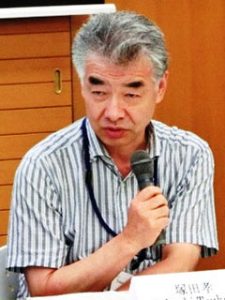 “Our colleagues at the Shanghai Academy of Social Sciences are forging ahead with large projects. I was surprised by the great difference in scale between our efforts and theirs. In Japan we do not have access to such massive funding for research, so I want to think deeply about what path we should take going forward.
“Our colleagues at the Shanghai Academy of Social Sciences are forging ahead with large projects. I was surprised by the great difference in scale between our efforts and theirs. In Japan we do not have access to such massive funding for research, so I want to think deeply about what path we should take going forward.
“In the discussion following Prof. Ma’s presentation I commented that the impact of the transition from the Qing to the Republican period seems to have been relatively tame, and now I must say that I was left with the same impression after all our Chinese colleagues’ presentations. It would be well if the significance of this question were explored in depth.
“In Japan there were of course aspects of early modernity that carried over into the modern period. However, there was also a great rupture: whereas we have plenty of documents that were produced and preserved by village and city neighborhood organizations in the Edo period, under modernity documents of that nature are no longer produced, and such documents as are produced at that level are in most cases not preserved. Thinking in comparative perspective about Japan and China, but also early modernity and modernity, is of crucial importance.
“Among our Shanghai colleagues’ presentations, some took the French Concession as their theme, others the old fortified city, which itself can be called an embodiment of tradition. Did the administration and governance of the Concession not in fact change despite the transition to the Republican government? I would like to work towards a firmer grasp on such questions of the shift from tradition to modernity.
“I just said that shift was enormous in Japan, but in medicine, for example, in some cases the Chinese-style doctors of the Edo period remained quite strongly rooted in their roles in rural areas. I hope that together we can develop perspectives that allow us broad and penetrating understanding of the political world and society on the ground.”
Ma Xueqiang
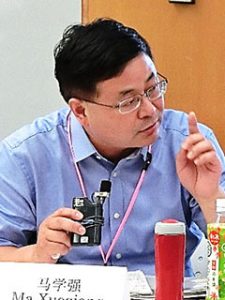 “With this symposium, over seventeen presentations and these concluding remarks, we have generated deeply significant discussion and debate.
“With this symposium, over seventeen presentations and these concluding remarks, we have generated deeply significant discussion and debate.
“I was most impressed by the extraordinary richness and variety of historical sources used in each talk, and I am of one mind with you all on the importance of emphasizing comparison. Over the past two days, in listening to the presentations from the scholars working in Japan, I learned a great deal about the use of sources that will help me in my research. Where we in China have sources like those available in Japan, we hope to follow in your footsteps; and where we do not, we must consider how we can overcome our limitations.
“The symposium was superbly run and the agenda was rich and varied: Osaka and Shanghai, urban structures, management—we have engaged each other from a variety of fascinating perspectives. In terms of modes of analysis for making urban connectivity visible, we have much to learn from our Japanese colleagues. From this symposium in particular, the presentations on waste disposal at Osaka castle and the surrounding villages and on plays and costume rentals come readily to mind.
“I hope we will be able to continue to deepen our collaborative research efforts. To that end, we should consider working together to come up with a research agenda. Abandoned children and poor relief, for example, might provide a good place to start as there is research on these subjects in Shanghai as well. Alternatively, we also want to expand our collaboration beyond the professoriate by inviting junior scholars to participate. With this explosion in the availability of digital information, let us advance our relationships of exchange like never before.
“I thank Profs. Tsukada and Saga, as well as those who served as our translators, Profs. Zhang Zhihui, Zhu Hong, Peng Hao, and doctoral candidate Wu Weihua.”
Zhang Zhihui
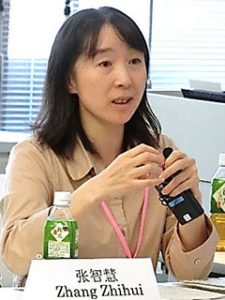 “The past two days were rich and stimulating, and I have learned a great deal. I offer my thanks to Prof. Tsukada and Saga. Our translators were essential to making it possible to participate in the symposium in both Japanese and Chinese, and they have worked tirelessly all the way through.
“The past two days were rich and stimulating, and I have learned a great deal. I offer my thanks to Prof. Tsukada and Saga. Our translators were essential to making it possible to participate in the symposium in both Japanese and Chinese, and they have worked tirelessly all the way through.
“I think we achieved a broad and deep scholarly exchange at this symposium. Speaking for myself, having been involved in building this relationship between Osaka and Shanghai from the first, I feel a great sense of achievement. At the same time, I also feel a renewed sense of mission to continue to deepen the relationship even further.”
Lastly, Prof. Saga offered words of thanks to Profs. Ma and Zhang, and those who served as translators (Profs. Zhang, Zhu Hong, Peng Hao, and doctoral candidate Wu Weihua), before closing the symposium with a round of mutual applause.

